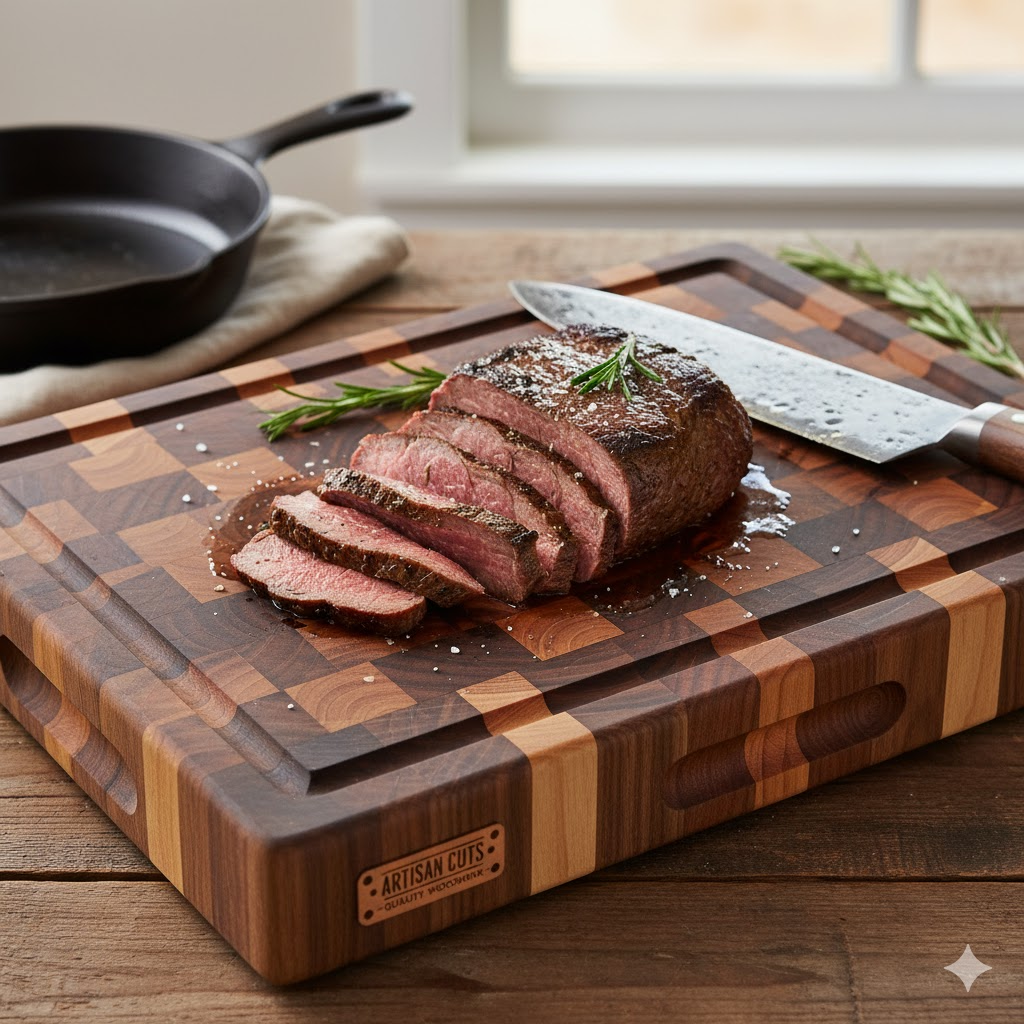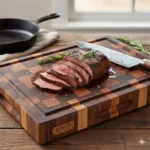Butcher Block Carving Board Some slice on flimsy plastic mats that curl up like wilted lettuce. Others scrape away on cold marble, killing their knives one chop at a time. But then, there’s another kind of cook. The one who owns a butcher block carving board. A thick, grounded piece of wood that feels alive. Like a tree decided to retire in your kitchen.
Once you use one—real use it—you get it. That low thud when your knife lands. The faint scent of oiled wood. The way it stays still, steady. You’ll never go back.
The Story Behind the Block
Butcher blocks weren’t invented for show kitchens or Instagram posts. They were born in blood. In noise. In the backrooms of 19th-century butcher shops.
Meat cutters discovered something simple—thick hardwood rounds survived the blade better than stone or steel. They didn’t crack, didn’t shatter took the beating. They aged. Each strike left a story. A groove, a scar, a history written in wood.
Time passed. The world changed. But the butcher block didn’t. It moved into kitchens with better lighting and cleaner hands. Now, it’s not a surface. It’s a feeling.
Cooking’s never about food. It’s about touch. Sound. The weight of tools that make you feel like you’re making something real.
What Exactly Is a Butcher Block Carving Board?
At first glance, it’s a cutting board. But it’s not.
It’s a slab. Thick, heavy, unapologetic. Made from hardwoods—maple, walnut, cherry. Built for work, not decoration.
Look close. You’ll see the grain. You’ll feel the difference. Some boards show end-grain, others edge-grain. Some carry juice grooves, carved handles, even tiny metal spikes to anchor a roast.
End-grain boards? That’s the good stuff. You’re staring at the wood’s cross-section—the fibers stand upright. When you cut, your knife slides between them. Gentle. Efficient. The board almost heals itself.
Edge-grain boards? Sleeker, cheaper, tougher. But they wear faster. Show scars.
Both belong in good kitchens. But end-grain—end-grain’s the legend.
The Anatomy of Quality: What Makes a Butcher Block Board Great
A real butcher block doesn’t warp. Doesn’t split. Doesn’t quit after six months.
Here’s what separates the heirlooms from the heartbreaks.
FeatureWhy It MattersWood TypeHardwoods like maple, walnut, and teak resist cuts, bacteria, and warping.Grain OrientationEnd-grain saves knives. Edge-grain saves money.ThicknessAnything less than 1.5 inches isn’t a butcher block. 3 inches is better.FinishFood-safe mineral oil or beeswax keeps the board alive and crack-free.Design DetailsGrooves, grips, feet, logos—they all add function and flair.
If it feels too light, too smooth, too cheap—it is. A true butcher block feels like it’s been here a while. Like it plans to stay.
End-Grain vs. Edge-Grain: The Eternal Debate
Every kitchen’s got that debate. End-grain or edge-grain. Tradition or practicality.
End-grain looks like a checkerboard. Each block shows the wood’s inner soul. When your knife hits, it slides into the fibers instead of fighting them. Your blade lasts longer. The board looks cleaner. There’s a soft rebound in every cut.
Edge-grain’s different. Long, lean strips of wood pressed side by side. Tougher. More rigid. Easier to clean. More affordable. But the knife feels it.
End-grain is for the purists. The ones who oil their boards like musicians polish violins. Edge-grain is for the efficient. The doers. The ones who cook, clean, move on.
There’s no wrong answer. preference.
The Craftsmanship Factor: Built, Not Manufactured
You can buy something called a “butcher block” in any big-box store. But most of them? They’re glued wood pretending to be heritage.
A true butcher block isn’t manufactured. It’s built.
Piece by piece. Cut, glued, sanded, seasoned. Every grain direction chosen. Every joint deliberate.
Small makers in the U.S., Canada, Europe—they treat these boards like furniture. Because that’s what they are. Furniture you can cook on.
They’re not about convenience. They’re about care.
Care and Feeding of a Butcher Block Carving Board
This isn’t a toss-in-the-sink kind of tool. A butcher block asks for love. Gives it back tenfold.
Do this:
-
Wash gentle. Warm water. Mild soap. Quick wipe. No soaking.
-
Dry upright. Let air move around it. Keeps it straight.
-
Oil monthly. Mineral oil. Beeswax if you’re fancy. Rub, rest, buff.
-
Clean natural. Salt and lemon for stains. Works like a charm.
It’s not hard. habit. Treat it like a good pair of boots.
Why Chefs Swear by Them
Ask any chef worth their apron. They’ll tell you—wood’s the only way.
There’s science behind it. Researchers at the University of Wisconsin found that bacteria die faster on wood than plastic. Wood pulls in moisture, traps the bacteria, starves it.
Plastic? It hides it in scratches.
Then there’s the feel. That soft resistance when a knife hits. The rhythm it gives. Every chop sounds like intention.
In fine-dining kitchens, surrounded by chrome and machines, you’ll still find a wooden block holding its ground.
Because some things never stop working.
Choosing the Right Butcher Block Carving Board for You
Not every cook needs a three-inch walnut monster. Start where you are.
PurposeBest TypeIdeal SizeNotesDaily ChoppingEdge-grain maple18x12″Easy, light, affordable.Heavy CarvingEnd-grain walnut24x18″Get a juice groove. You’ll thank yourself.Display / ServingCherry or teakVariableLooks good on the table.Professional UseMaple or oakCustomThick, sturdy, built to last.
If you cook often, invest. If you dabble, keep it simple. But once you feel the difference—you’ll start collecting them.
Sustainability and the Story of the Trees
Every butcher block starts the same way. As a tree. Alive. Breathing. Growing for decades.
Good makers know this. They use FSC-certified wood, reclaimed lumber, or offcuts. No waste. No guilt.
It’s more than a board. It’s a second life. A piece of nature invited back into the kitchen.
If you care about what’s on your plate, care about what it’s cut on.
The Butcher Block in Modern Design
Flip through any design magazine. You’ll see them. Butcher blocks everywhere.
They’re not hiding in drawers anymore—they’re part of the aesthetic. A thick walnut slab sitting on white marble? That contrast hits different.
Designers use them to warm up cold spaces. To bring nature indoors. To remind you cooking’s still a craft.
Because steel appliances don’t tell stories. Wood does.
DIY Dream: Building Your Own Butcher Block Board
If you’ve got sawdust in your veins, make your own.
You’ll need hardwood, clamps, glue, patience. Cut equal pieces. Align the grain. Glue, clamp, wait. Plane, sand, oil.
It’s a process. A quiet one. Smells like effort. Feels like pride.
Then, the first time you carve meat on it—you’ll know. It’s yours.
Trends & Future of Butcher Blocks
Innovation doesn’t skip tradition.
Now we’re seeing wood mixed with resin. Hidden scales. Built-in drip channels. Even antibacterial coatings.
But deep down, it’s still the same. A solid block of wood connecting cook to craft.
In a world of smart kitchens, butcher blocks stay human.
Final Thoughts: More Than a Board
A butcher block carving board is a stage. The opening act of every meal.
It’s where onions cry. Where knives sing you start. Where you end.
It’s not a board. It’s a ritual.
Get one. Feel its weight. Listen to that sound. Smell the oil. You’ll understand why chefs, home cooks, and artisans keep coming back to the block.
FAQs About Butcher Block Carving Boards
1. What wood is best for a butcher block carving board? Maple’s the classic—tough, tight-grained, natural antibacterial. Walnut’s darker, softer on knives, elegant.
2. How often should I oil my board? Once a month. Or when it looks dry. Keep it fed.
3. Can I wash my butcher block board in the dishwasher? No. Ever. The heat, the steam—it’ll ruin it.
4. What’s the difference between a butcher block and a cutting board? Thickness and purpose. Butcher blocks are heavy-duty. Cutting boards are lighter, portable.
5. How do I remove stains or smells? Salt and lemon. Scrub, wait, rinse. Simple.
6. Are plastic boards safer than wood? No. Wood wins in the long run. Bacteria die faster.
7. Can I use both sides of a butcher block? Yes. Unless it’s got feet or a groove. Oil both sides even.
8. What size board should I buy? 18×12 for daily use. Bigger if you carve roasts.
9. Do butcher block boards dull knives? No. They preserve them. Wood’s softer than steel.
10. How long does a butcher block last? Forever—if you care for it. Some become family heirlooms.











